
High and Dry in Northern Chile
After our brief moment in Northern Argentina, we aimed to cross into northern Chile via Paso de Jama. Arriving at the border, we couldn’t believe we were adding the 16th country to our list. 
 Crossing into Chile is no easy task, as they are very strict. The border agents proceeded to search our entire vehicle and confiscated spices, a few nuts not eaten, and sadly our machete that we purchased in Guatemala. We made a mental note on how to cross into Chile better prepared next time.
Crossing into Chile is no easy task, as they are very strict. The border agents proceeded to search our entire vehicle and confiscated spices, a few nuts not eaten, and sadly our machete that we purchased in Guatemala. We made a mental note on how to cross into Chile better prepared next time. Leaving the border mid day, we were gifted with perfect weather and other-worldly vistas. It should be noted that we had been hanging out at around 4000 meters (above 13,000ft) for several weeks in the Altiplano and Paso de Jamas topped at at almost 5000 meters (16,000ft) at its summit. Despite the heavy breathing, Koru also did well at the highest elevation he has ever been.
Leaving the border mid day, we were gifted with perfect weather and other-worldly vistas. It should be noted that we had been hanging out at around 4000 meters (above 13,000ft) for several weeks in the Altiplano and Paso de Jamas topped at at almost 5000 meters (16,000ft) at its summit. Despite the heavy breathing, Koru also did well at the highest elevation he has ever been.
 With no one around except some flamingos and vicunas, we opted to take our time in this region before arriving in the next town of San Pedro de Atacama. With side roads everywhere, we chose one and after a few short kilometers we discovered incredible and solitary rock formations.
With no one around except some flamingos and vicunas, we opted to take our time in this region before arriving in the next town of San Pedro de Atacama. With side roads everywhere, we chose one and after a few short kilometers we discovered incredible and solitary rock formations.

 The extreme elevations and landscapes in this part of the country gave the impression of another planet. It was strange for us to be hanging out around 15,000 feet with even larger mountains all around us.
The extreme elevations and landscapes in this part of the country gave the impression of another planet. It was strange for us to be hanging out around 15,000 feet with even larger mountains all around us.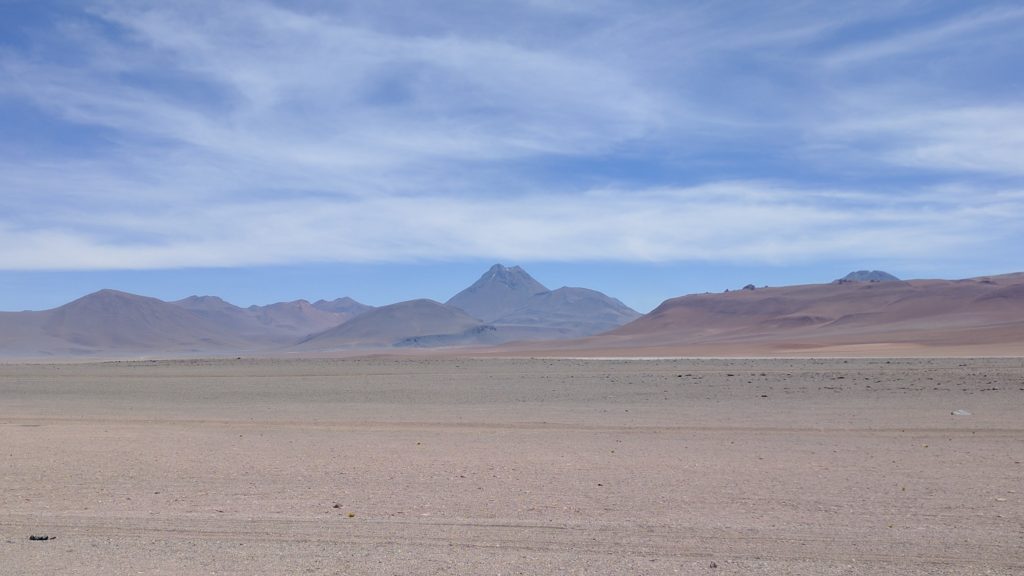 Sarah realized there was a volcano nearby with a trail to the top and what appeared to be some sort of ‘road’ that arrived close to the base. Assessing our food and water to make sure we had enough supplies, we decided to go for it and see where the trail would take us!
Sarah realized there was a volcano nearby with a trail to the top and what appeared to be some sort of ‘road’ that arrived close to the base. Assessing our food and water to make sure we had enough supplies, we decided to go for it and see where the trail would take us! After 12 miles driving through mars-like terrain, dry river basins with salt flats in the distance and a mini rock garden to test Matt’s real-life Mario Kart skills, we decided to stop where the road started to get steep.
After 12 miles driving through mars-like terrain, dry river basins with salt flats in the distance and a mini rock garden to test Matt’s real-life Mario Kart skills, we decided to stop where the road started to get steep.  Positioning Koru behind the only rock that had a chance of deflecting the howling winds, our elevation check was at more than 15,200ft. Volcano Acamarachi‘s (also known as Pili) summit is at 6,046 meters (19,836ft) in elevation. Considering there is no snow or ice to cross, and the climate was in our favor, we settled in for a surprisingly good night of sleep during cold temps while full of anticipation for the following day.
Positioning Koru behind the only rock that had a chance of deflecting the howling winds, our elevation check was at more than 15,200ft. Volcano Acamarachi‘s (also known as Pili) summit is at 6,046 meters (19,836ft) in elevation. Considering there is no snow or ice to cross, and the climate was in our favor, we settled in for a surprisingly good night of sleep during cold temps while full of anticipation for the following day. With breakfast and coffee finished in the dark, we set off with headlamps guiding the way and reached an elevation of around 16,500ft as the twilight show was beginning to display our goal.
With breakfast and coffee finished in the dark, we set off with headlamps guiding the way and reached an elevation of around 16,500ft as the twilight show was beginning to display our goal. 
 Daylight arrived and we felt good energy, so we headed up and up. Most of the time there wasn’t a trail, so we did our best and picked our way up through the paths of least resistance.
Daylight arrived and we felt good energy, so we headed up and up. Most of the time there wasn’t a trail, so we did our best and picked our way up through the paths of least resistance.
 Close to the saddle, we passed large ice pinnacles called penitentes that were simply breathtaking and something neither of us had ever witnessed.
Close to the saddle, we passed large ice pinnacles called penitentes that were simply breathtaking and something neither of us had ever witnessed.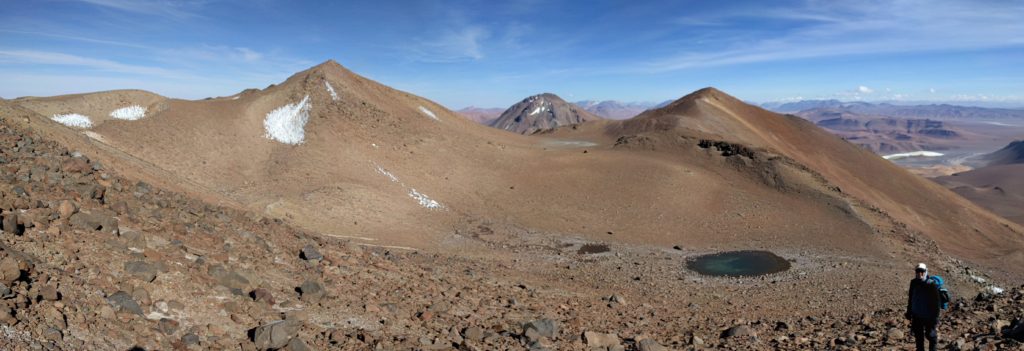 Arriving at the saddle, the views were starting to show, but we still had a lot of elevation to gain, so we took it slow and steady to the top. We had been traveling at or above 13,000ft for the previous 3 weeks fortunately, so our bodies were acclimated and did well with the thin air.
Arriving at the saddle, the views were starting to show, but we still had a lot of elevation to gain, so we took it slow and steady to the top. We had been traveling at or above 13,000ft for the previous 3 weeks fortunately, so our bodies were acclimated and did well with the thin air.  Success! We reached the highest elevation either of us have ever stood and we felt great! After the lumbering of our wobbly legs up the final section, we were treated with an unbelievable 360 degree view that just took our breath away.
Success! We reached the highest elevation either of us have ever stood and we felt great! After the lumbering of our wobbly legs up the final section, we were treated with an unbelievable 360 degree view that just took our breath away. The descent of this volcano was steep and difficult, so we didn’t hesitate and headed down after a quick 20 minutes on the summit.
The descent of this volcano was steep and difficult, so we didn’t hesitate and headed down after a quick 20 minutes on the summit.
 Our goal was to get back to the van before dark and continue into the town San Pedro de Atacama where we really needed to re-supply.
Our goal was to get back to the van before dark and continue into the town San Pedro de Atacama where we really needed to re-supply. 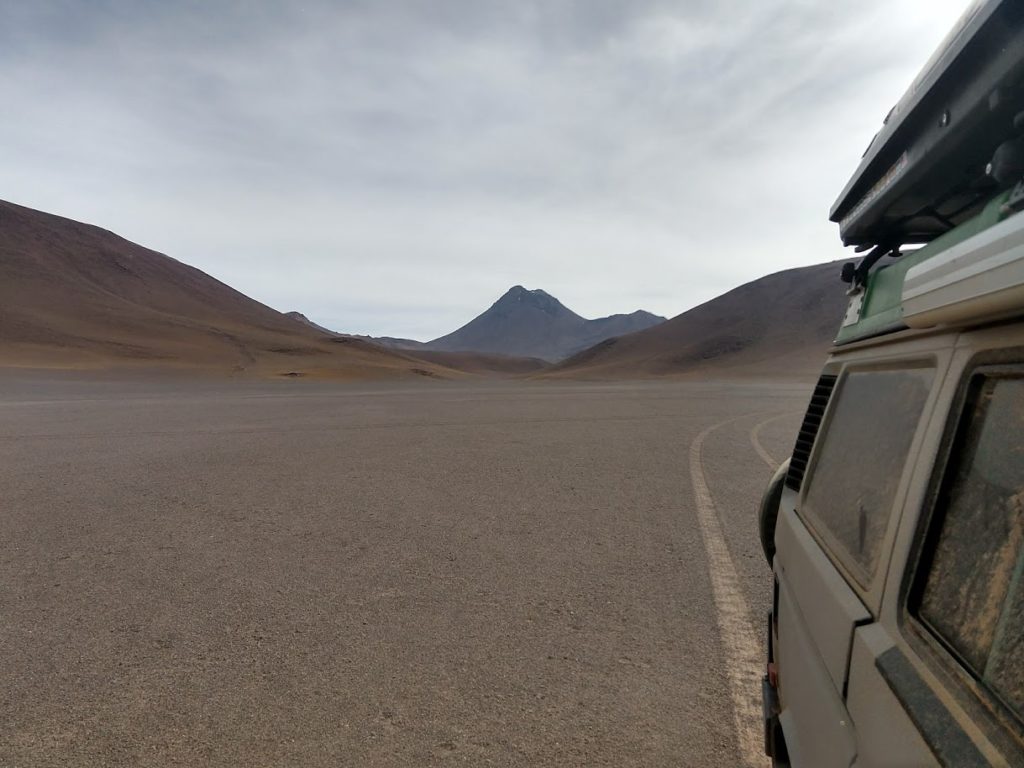 After a successful descent, still in awe that we hiked a peak over 6000m, we headed back towards the highway while we waved goodbye to Pili.
After a successful descent, still in awe that we hiked a peak over 6000m, we headed back towards the highway while we waved goodbye to Pili. San Pedro de Atacama is the Moab of Chile, full of adventure tourism. Exhausted and hungry, we grabbed a celebratory burger and headed out of town to a campground we had read about for a stunning sunset.
San Pedro de Atacama is the Moab of Chile, full of adventure tourism. Exhausted and hungry, we grabbed a celebratory burger and headed out of town to a campground we had read about for a stunning sunset. Here we were welcomed with open arms by other travelers whom we quickly befriended. Staying for two nights, we had a kitchen to use, took showers, washed some clothes, and relaxed with a stunning view which are essentially all of the big ticket items while living in a van.
Here we were welcomed with open arms by other travelers whom we quickly befriended. Staying for two nights, we had a kitchen to use, took showers, washed some clothes, and relaxed with a stunning view which are essentially all of the big ticket items while living in a van. After our short stay we headed back on the road diving headfirst in to the driest desert in the world, the Atacama. Sarah’s friend was coming to visit in just a short two weeks and we wanted to explore northern Chile before his arrival.
After our short stay we headed back on the road diving headfirst in to the driest desert in the world, the Atacama. Sarah’s friend was coming to visit in just a short two weeks and we wanted to explore northern Chile before his arrival.  We stopped at Valley de la Luna and took in more incredible desert landscapes.
We stopped at Valley de la Luna and took in more incredible desert landscapes.  What we had in front of us was something unique so far to this trip, hundreds upon hundreds of uninterrupted miles on good paved roads between easily navigable towns. Between San Pedro de Atacama and Santiago we drove over 1700km (1100mi), needless-to-say we put a lot of windshield time in for this stage of the trip.
What we had in front of us was something unique so far to this trip, hundreds upon hundreds of uninterrupted miles on good paved roads between easily navigable towns. Between San Pedro de Atacama and Santiago we drove over 1700km (1100mi), needless-to-say we put a lot of windshield time in for this stage of the trip.  And just when we got tired, we discovered a large desert hand to help us to keep on keepin’ on through the vast Atacama desert.
And just when we got tired, we discovered a large desert hand to help us to keep on keepin’ on through the vast Atacama desert.  Eventually, we re-encountered our old friend, the Pacific Ocean. As one can imagine, abundant remote coastal locations exist in Northern Chile. During our drive days, it was fairly easy to find amazing wild beach camping.
Eventually, we re-encountered our old friend, the Pacific Ocean. As one can imagine, abundant remote coastal locations exist in Northern Chile. During our drive days, it was fairly easy to find amazing wild beach camping.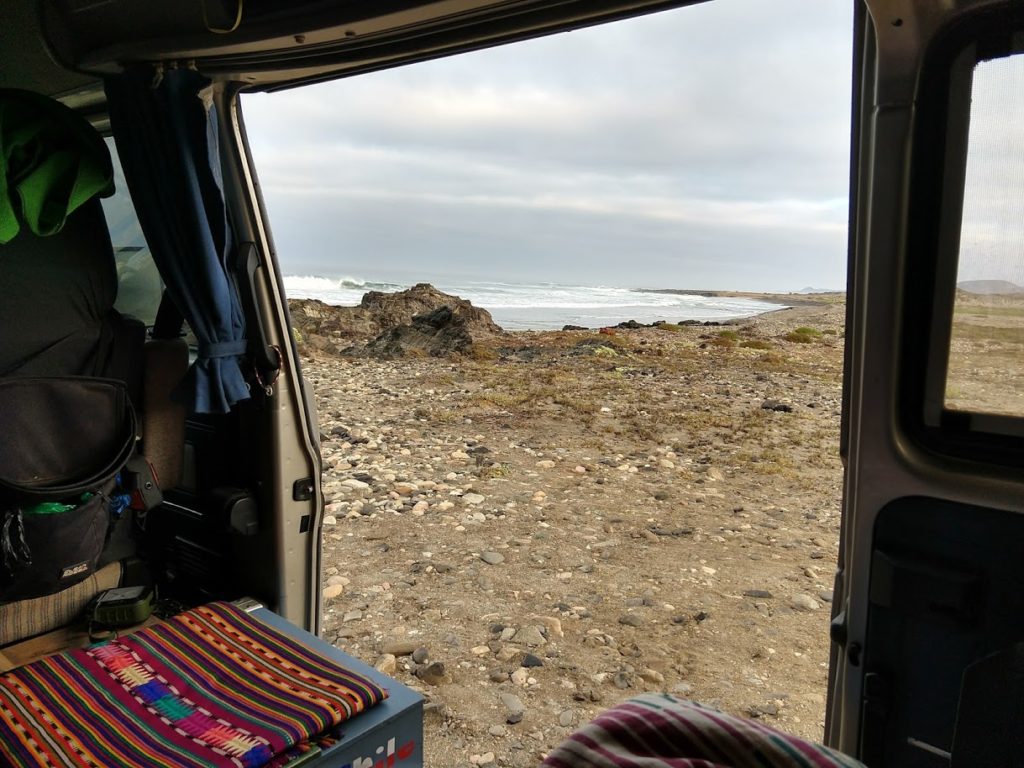 On our way south, we made a pit stop at the old border between Bolivia and Chile before the War of the Pacific in 1879, which changed everything and left Bolivia much smaller and without a coast.
On our way south, we made a pit stop at the old border between Bolivia and Chile before the War of the Pacific in 1879, which changed everything and left Bolivia much smaller and without a coast.
 Heading further and further south, Bahia Inglesa offered an exciting mini adventure through the Paleontology Park. This open air park was chalked full of fossils that were exposed during mining operations in the area. Conservation efforts have now protected it and scientists are still discovering new fossils regularly.
Heading further and further south, Bahia Inglesa offered an exciting mini adventure through the Paleontology Park. This open air park was chalked full of fossils that were exposed during mining operations in the area. Conservation efforts have now protected it and scientists are still discovering new fossils regularly.
 Northern Chile is considered the best place in the world for star gazing with over 70% of the world’s observatories. Realizing the opportunity, we drove the famous ‘Ruta de las Estrellas’ (Route of the stars) and planned to take a tour of one of the many observatories.
Northern Chile is considered the best place in the world for star gazing with over 70% of the world’s observatories. Realizing the opportunity, we drove the famous ‘Ruta de las Estrellas’ (Route of the stars) and planned to take a tour of one of the many observatories.  We detoured into the Elqui Valley to the town of Vicuna, which is famous for observatories and pisco distilleries. Arriving in the late afternoon, there was a lot of activity in the main square and we quickly figured out that there was a free concert that night.
We detoured into the Elqui Valley to the town of Vicuna, which is famous for observatories and pisco distilleries. Arriving in the late afternoon, there was a lot of activity in the main square and we quickly figured out that there was a free concert that night.
 Loving the music, we stayed until the bitter and decided to do our tours the next day.
Loving the music, we stayed until the bitter and decided to do our tours the next day.  With clear skies and grape vineyards occupying the valley floor we headed to Aba distillery for a free tour and explanation of the pisco production process.
With clear skies and grape vineyards occupying the valley floor we headed to Aba distillery for a free tour and explanation of the pisco production process.
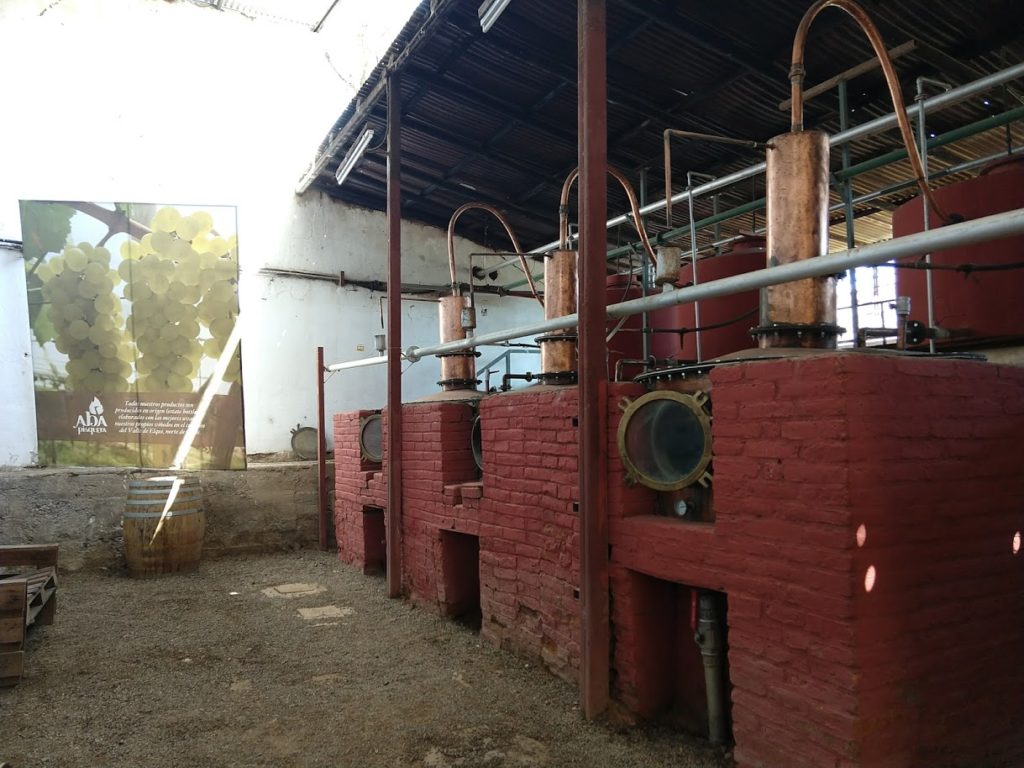
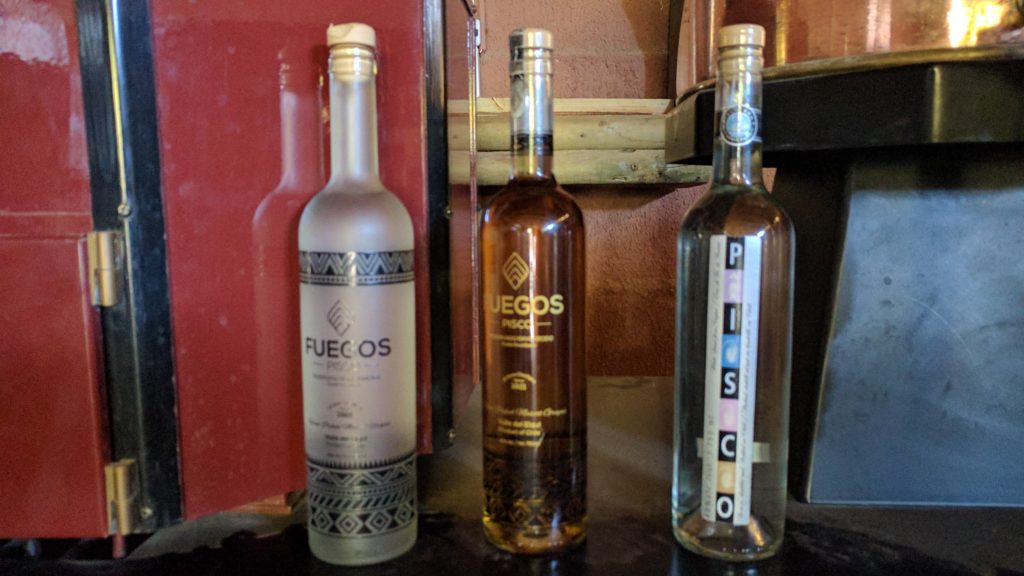 That evening we drove up a nearby mountain and awed over our universe at the Mamalluca Observatory. Unable to take photos, this is all we have, two exhausted gringos at 1:30a stoked on the sky.
That evening we drove up a nearby mountain and awed over our universe at the Mamalluca Observatory. Unable to take photos, this is all we have, two exhausted gringos at 1:30a stoked on the sky. Now that we were confident in identifying the southern cross among other southern hemisphere constellations, we kept our noses pointed south to Santiago. On the way, for about 10 miles on the highway near La Ligua there were people with covered baskets trying to wave people over.
Now that we were confident in identifying the southern cross among other southern hemisphere constellations, we kept our noses pointed south to Santiago. On the way, for about 10 miles on the highway near La Ligua there were people with covered baskets trying to wave people over.  At first we were uninterested, but after about 15 minutes of white plastic batons getting waved in front of us, we decided to stop and were glad we did! They were selling meringue style cookies made only in La Ligua. We bought a delicious half dozen and continued south.
At first we were uninterested, but after about 15 minutes of white plastic batons getting waved in front of us, we decided to stop and were glad we did! They were selling meringue style cookies made only in La Ligua. We bought a delicious half dozen and continued south. Santiago was surprisingly easy to navigate and had the feel of a very modern city. We enjoyed exploring the sights from the viewpoint accessed by a gondola and discovered ‘mote con huesillo‘ drinks.
Santiago was surprisingly easy to navigate and had the feel of a very modern city. We enjoyed exploring the sights from the viewpoint accessed by a gondola and discovered ‘mote con huesillo‘ drinks. 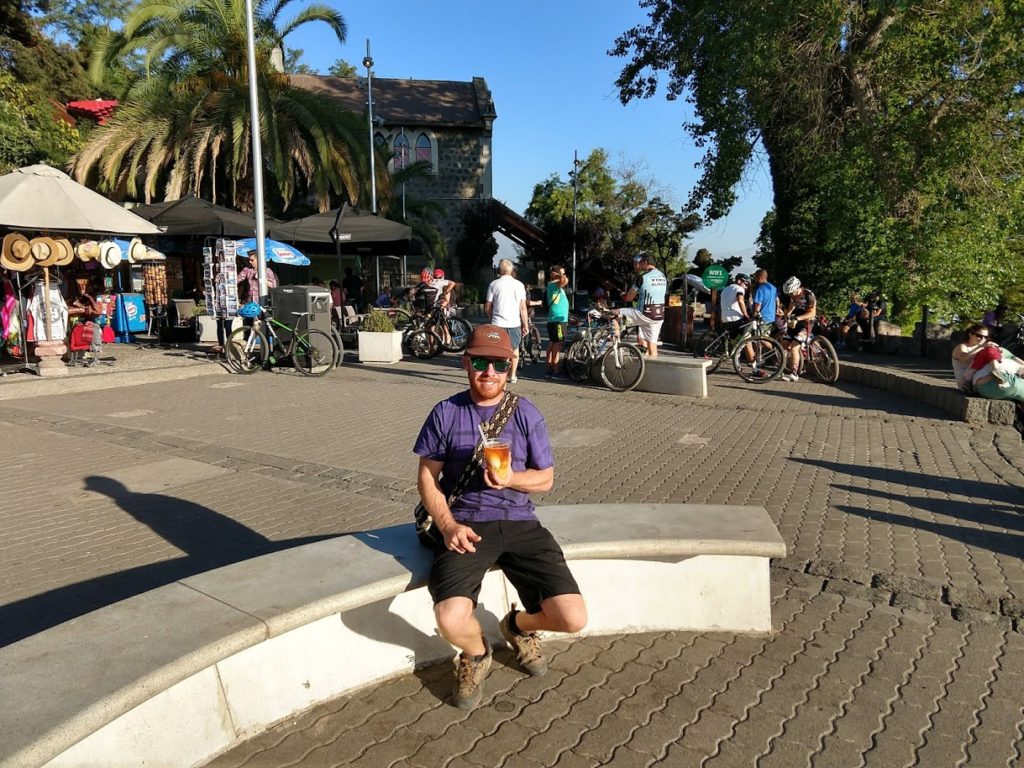 While in Santiago we had plans to visit a Vanagon enthusiast mechanic to have Koru’s timing belt changed.
While in Santiago we had plans to visit a Vanagon enthusiast mechanic to have Koru’s timing belt changed.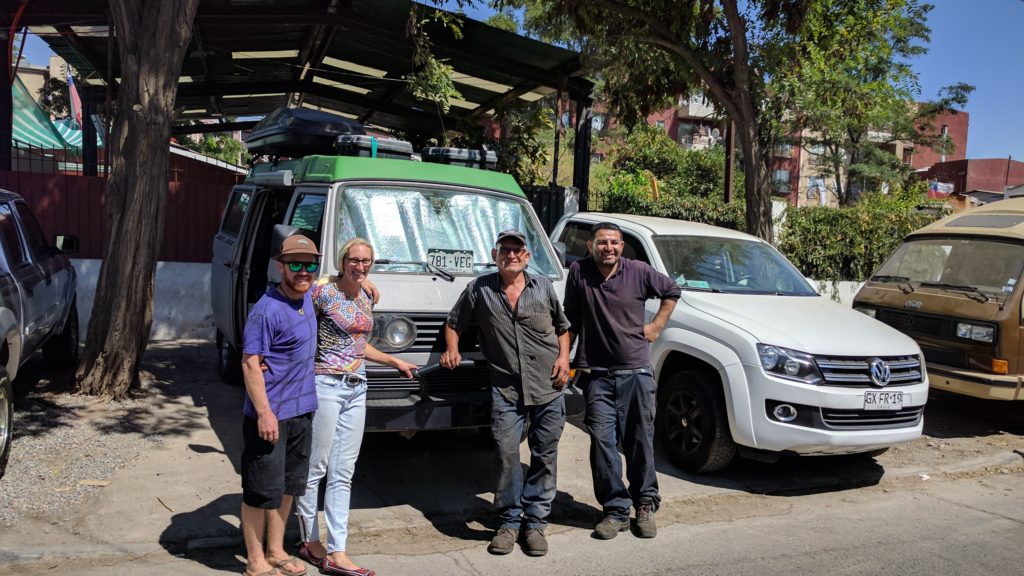 The T3 Westfalia gurus of Chile operate their shop and club in Santiago, so it felt good to let some fellow van lovers work on Koru. We also had the pleasure to meet some fellow travelers from Argentina having some work done on their rare VW Karmann camper.
The T3 Westfalia gurus of Chile operate their shop and club in Santiago, so it felt good to let some fellow van lovers work on Koru. We also had the pleasure to meet some fellow travelers from Argentina having some work done on their rare VW Karmann camper. After the van was all buttoned up, we headed for the coast to witness Valparaiso, considered the San Francisco of South America and full of bohemian vibes and street art everywhere.
After the van was all buttoned up, we headed for the coast to witness Valparaiso, considered the San Francisco of South America and full of bohemian vibes and street art everywhere.

 Unfortunately we had limited time in Valparaiso, but we thoroughly enjoyed the time we did have.
Unfortunately we had limited time in Valparaiso, but we thoroughly enjoyed the time we did have.

 Sarah’s friend Shawn was arriving the next day to explore Chile with us for almost two weeks. We were excited to hike big mountains, climb and surf together. So, off we returned to Santiago for the next chapter in our Chilean adventure.
Sarah’s friend Shawn was arriving the next day to explore Chile with us for almost two weeks. We were excited to hike big mountains, climb and surf together. So, off we returned to Santiago for the next chapter in our Chilean adventure.
3 thoughts on “High and Dry in Northern Chile”
Great photos again. Had no idea that northern Chile was so dry. The hike up Volcano Pili to get to over 6000 meters is an awesome accomplishment shared by few. Congrats!!!
Queridos amigos..increíble lugar!!!..aunque me da un poco de susto estar en medio de tremendo desierto..estuvieron en el medio de la nada…los paisajes son completamente lunares..no puedo creer lo alto que llegaron ..5000 mts..es peligroso si tu cuerpo no está preparado..pero una vez más me quedo muy impresionada por el espíritu aventurero que comparen como pareja.
Nunca he escuchado sobre las formaciones de hielo conocidas como penitentes..
Chile es un país de muchos contrastes…y qué les pareció el pisco?..hasta ahora no sé si es peruano o chileno.
Me alegro mucho que salieron a festivales..a disfrutar con amigos y a conocer la cultura chilena.
En realidad como tú dices..la guerra con Bolivia, trajo como consecuencia la pérdida de su territorio y su salida al mar, que hasta hoy es un conflicto en la región que no se supera.
Hermosas fotos..éste lugar es desconocido como punto turístico para visitarlo.
Un abrazo a la distancia.
Se les recuerda siempre.
Paulina
I am in awe of your great pictures, the landscape, your hiking abilities and all that you are seeing and doing! Thank you SO much for including us with your email adventures and awesome photography. Do so look forward to your next post and hearing of your adventures. We just returned from a mundane trip to Europe for a month but loved every minute and saw wonderful things as well.
Hugs to you both, Gail